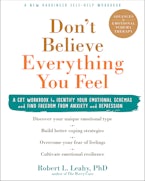By Robert Leahy, PhD, author of Don’t Believe Everything You Feel
Although many of us would like to live a life of serenity and complete happiness, the reality of a life worth living is that we all will experience painful emotions at some time. There is no way to get through life without experiencing anxiety, anger, sadness, confusion, disappointment, envy, and a full range of unpleasant feelings. We are not robots and we are likely to trip over each other, lose relationships, and feel hurt at times.
For many years I heard people complain that cognitive behavioral therapy (CBT) placed too much emphasis on logic and rationality, and not enough on emotions. After thinking about this and reflecting on my own life, I realized that this was a valid point. I then began developing a new approach to emotions—that I think is within the CBT tradition—that I call “Emotional Schema Therapy.” What I mean by this is that each of us has our own beliefs and strategies about our emotions and those of others.
Consider two young men facing a breakup in a relationship. Each of them has just received a text message from their respective girlfriends. Michael hears from Miranda who says, “Don’t contact me, it’s over.” Michael is initially confused and anxious, then angry, then sad, and even relieved. He is able to turn to his friend, Francesco, who lends a sympathetic ear, validating Michael’s feelings. Michael is able to realize that his feelings are a normal part of a breakup, others would feel a wide range of emotions, his feelings are temporary, and he will not fall apart because he has these feelings. He realizes he can learn from the relationship and that he has the capacity to connect with someone. Michael is a mensch—a “real human being”—who can accept and live with difficult feelings. But his neighbor, Nate the Neurotic, has a different response to his breakup with Nina. Although Nate has a full range of feelings similar to those that Michael describes, he has a different response to those feelings. Nate believes that he shouldn’t feel so bad; he thinks these feelings will last forever, that he is out of control; he feels ashamed that as a man he is so “weak;” he cannot comprehend why he has conflicting feelings, and he fears he will go insane. He is too ashamed to share his feelings with his friend, Steve, so he will not get validation. He will not learn that others might feel the same way. Because he has such negative interpretations of his feelings, he now isolates himself with the shame that he struggles with, he drinks heavily, and he stops doing the things he used to enjoy.
It is not simply the painful feelings that we have; it is how we respond to those feelings. In Don’t Believe Everything You Feel, I outline fourteen dimensions of how we think about our emotions. I identify a number of problematic strategies of coping with emotion—such as rumination, avoidance, worry, blaming, self-loathing, substance abuse, and excessive reassurance-seeking.
I describe five principles of the emotional schema approach that are part of a full life:
-
Difficult and Unpleasant Emotions Are Part of Everyone’s Experience
-
Emotions Warn Us, Tell Us about Our Needs, and Connect Us with Meaning
-
Strong Emotions Can Lead Us or Mislead Us
-
Beliefs about Emotions Can Make It Difficult for Us to Tolerate Our Feelings
-
Strategies for Coping with Our Emotions Can Make Matters Better or Worse
I also describe strategies for coping with the complexities of real life—not an ideal life:
-
Emotional Realism: Life will entail a full range of emotions—painful and pleasurable. It comes with the territory.
-
Inevitable Disappointments: You will be disappointed and disappoint others. Friends and partners don’t always live up to our expectations, but we can still connect and grow together.
-
Constructive Discomfort: Making progress will involve doing things that are uncomfortable. If you think you should not be uncomfortable, then you won’t make progress. Discomfort is temporary and helps build resilience.
-
Do What You Don’t Want to Do: We can only make progress if we build self-control and self-discipline. This means doing what you do not want to do to get what you really want to get. Doing the hard things makes life easier in the long run.
-
Successful Imperfection: You will make progress—not perfection—if you continue to move in the right direction, imperfectly. Embracing imperfection as a means to an end will help you achieve your goals.
-
Flexible Satisfaction: Our expectations get in the way of living in the real world. Adjusting our expectations so that we can find satisfaction and contentment is a better strategy than protesting or giving in to despair.
Throughout the book, I share with you my own experiences in life and those of clients who have shared their experiences with me. We can learn from sadness, anger, and anxiety, and we can expand our capacity for a richer life while making room for all the waves of difficulty that come our way. We can ride those waves rather than drown in their depths.
Robert L. Leahy, PhD, is author or editor of twenty-seven books, including The Worry Cure. He has led or been heavily involved with many national and international cognitive behavioral therapy (CBT) organizations. He writes a regular blog for Psychology Today, and has written for HuffPost. Leahy is an international speaker at conferences worldwide, and has been featured in print, radio, and television media such as The New York Times, The Wall Street Journal, The Times, The Washington Post, 20/20, The Early Show, and more.



 Part 2: What to Do When a Client Is Participating in Self-Judgment?
Part 2: What to Do When a Client Is Participating in Self-Judgment?